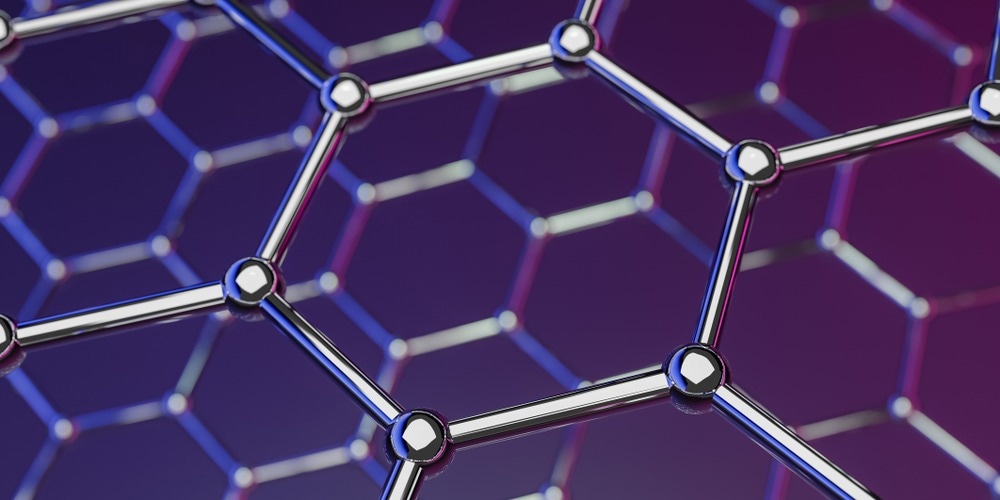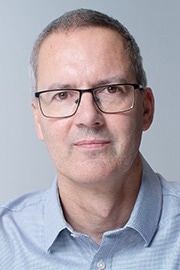AZoM spoke with James Baker from Graphene@Manchester about the growth of graphene as an advanced material and its potential to shape the future of multiple sectors.
Could you please introduce yourself and your professional background?
I’m the CEO of Graphene@Manchester, so I am part of the University of Manchester, but not an academic. I'm really associated with the commercialization of graphene and 2D materials. My background is in the industry; I worked for over 25 years in aerospace and defense. Before joining the university I was running the Technology Centers of BAE Systems in the UK, so very much around technology commercialization, but now as CEO of Graphene@Manchester the role is very much around partnering with industry to create a supply chain and commercializing graphene products and applications.
Graphene@Manchester is an innovative graphene research hub that has enabled the development of several graphene applications. As CEO, could you comment on some of the goals and ambitions of the program?
Graphene@Manchester has been set up really to focus on the commercialization of graphene and 2D material products and applications. As well as this, we still have the National Graphene Institute, which is focused on research on not just graphene but a whole family of two-dimensional 2D materials— today over 150 2d materials. In the future, they'll be designing stacks of multifunctional, layered materials.
Plenty of science takes place, but the key focus of our second building, the Graphene Engineering Innovation Center, or the GEIC, is really about the translation of that science into products and applications. We still do great science around papers, publications, and new science, but really Graphene@Manchester, and the GEIC, are focused on that translation, and already we're seeing products in the marketplace, despite graphene being only 18 years young.
How is the GEIC able to fast-track the process from conceptualization to application?
We call it the Manchester model. If you do things traditionally, it can take many tens of years from the discovery of a new material to those end products and applications in the marketplace, but through the National Graphene Institute and the GEIC, we're really trying to accelerate that whole innovation cycle to do things a lot quicker. If I use an example of graphene-enabled concrete, as well as doing the traditional testing and development, we do what we call living labs. As well as doing the science we've done an actual pour of concrete on a road, allowing a real-world experiment where we get data that enables us to accelerate in the future from that knowledge. This is a key part of what we call the Manchester model.
With help from the GEIC, how will graphene materials aid technological advancements over the next 10 years?
Eighteen years sounds like a long time, but for any new material, it can typically take 25-plus years before products are in the marketplace. Already we're starting to see products like rubber sole shoes and paints where graphene is added into things to start to make a real difference. So in terms of breakthroughs, we're already seeing products in the marketplace. Some of those are enhancements to existing products, and others are brand new forms of batteries, for example, or supercapacitors, where we're starting to get really new products into the marketplace as well. So it’s a really exciting time—although graphene's very young, we're already seeing products and applications enter the market.
One of the great things we are doing with graphene is growing lettuces and tomatoes in the GEIC with new hydrogels instead of peat or rockwool. From vertical farming through to space satellites through to rubber shoes to new membranes for water desalination, graphene is incredibly exciting.
There has been a significant shift across most industries toward greener manufacturing, planning, and development. How can graphene contribute to sector-wide sustainability?
We’re all now driven by this move towards net zero. In Manchester, the goal is 2038, and in the UK 2050. Advanced materials can really play a role from lower amounts of concrete to being able to reuse recycled materials. Another great example is we can take a waste tire, a tire from your car, which often ends up on a scrap heap and shipped onto waste piles around the world, and by chopping the rubber up into rubber crumb and adding a small amount of graphene you can then upcycle it to get a high performing mat or product. As a real area of sustainability, driven by sustainability, graphene as an additive to recycled materials means you can potentially reuse that material many, many times.

Image Credit: Production Perig/Shutterstock.com
Another example is potentially bottled water. Can we take the plastic, chop that plastic up and reuse it, or even use a biomaterial as an alternative?
Roads are another great area. We've done a small piece of work with National Highways which looks after the road network in the UK. We're taking a recycled aggregate from the road, a little bit of graphene, and we've reused that to make hopefully a stronger road that doesn't have potholes when it gets cold or when it gets hot as it's strong but also flexible in heat and cold.
So again, there are some real examples where graphene can start to play a role in a more sustainable future. And then, we're also looking at making our buildings or our highways smarter. Can we build sensors into the roads to tell you whether it needs to be treated, whether it's damaged, or even build charging into the roads? In the future, maybe as you're waiting at traffic lights, you can recharge your car while you're waiting. There are some really great opportunities where graphene can start to play a real role in the world and the environment we work and live in.
Why is it important to develop smart or advanced materials like graphene in sectors like construction and urban planning?
One of the most exciting initiatives that we've been involved in recently is graphene and concrete. Concrete can be quite boring, but globally concrete contributes 8% to 10% percent of global CO2 emissions. We've found that by adding as little as 0.01% graphene into concrete, we could potentially use up to 30% less material.
If we could use graphene cement or concrete in all of our construction, we could globally reduce CO2 emissions by around 2% or 3%. For me, if I think of the sustainability agenda of the reduction of CO2, just a very small amount of graphene in concrete would really make a big difference, not just to the buildings we live in.
How can we facilitate the greener manufacture of graphene ahead of its use in sustainable technologies?
When we talk about greener manufacturing, it's the whole life cycle or the whole product that's important. So typically graphene today still comes from graphite. We take graphite from a mine and we break it down into sheets or several sheets of graphene, but increasingly we're seeing a trend towards greener ways of manufacturing graphene, including from methane, such as from waste products where you capture methane and break that down into graphene and hydrogen.
What is graphene? A sustainability story
Video Credit: The University of Manchester – The home of graphene/Youtube
We could also take tires or bottles again and extract the carbon from them and reuse that as graphene, allowing local manufacturing and local supply chains. Increasingly we're seeing a real move towards greener ways of producing graphene material. And particularly for recycling, it means you don't have to start shipping materials around the world.
You are participating in a talk at the Advanced Materials Show at the NEC this month on using smart and advanced materials such as graphene to enable durable urban development. Could you describe some of the key points you will be covering?
For me, this show is a good chance to talk about the developments around graphene and other 2D materials and how that can impact urban planning, the environment, buildings, and construction. Graphene is a great case study for everything from concrete to anti-corrosion coatings to smart sensors. The talk is around what impact advanced materials can have, whether it's graphene or another advanced material, but also more about ‘how do we change the whole business model of engagement?’ Why does it take us so long?
The main purpose of being at the Advanced Materials Show and supporting events like that is, in my language, we want to create the supply chain. We want to bring academia closer to industry and materials suppliers, work with product suppliers, as well as work with end users.
So really it's about that integration, working together in collaboration to accelerate the adoption of graphene and 2D materials. The Advanced Materials Show for me is a great format for doing that. I know people are coming from the UK and from internationally.
It's probably one of the busiest weeks we've had for a long, long time. A lot of people seem to be coming to the Advanced Materials Show in Birmingham and then we're getting requests on the Monday and the Friday to come to Manchester to visit the GEIC. I think it's a great opportunity to showcase not just graphene, but some of the technology, materials, and industries across the UK, and I think it should be an exciting show.
What human opportunities will the growth of the graphene industry open up for scientific talent?
We have now worked with over 300 industrial partners over the last 10 years or so. But one of the really exciting things we're seeing at the moment is in the last eight years we've been associated with 44 startups or spin-outs from the University of Manchester. And what we're starting to see now is those startups and spin-outs are starting to recruit people.
We are really looking to attract talent, whether it's engineers or just people associated with business, not just in Manchester but across the graphene supply chain. I was talking to a company based in Cambridge that will be growing from 100 to 200 people over the next year. So we're starting to see real growth in jobs and opportunities. And for me, if there's a final point to make, it could be a really exciting role or opportunity for people for a career around advanced materials, whether it's making the materials or the products or the marketing. For me, there are some real quality opportunities hopefully going forward. And again, hopefully, people will see that over the coming weeks and months.

About James Baker
 James joined the University of Manchester after 25 years in the Industry where most recently he was Vice-President of Technology Collaboration Programmes and Managing Director of the Advanced Technology Centres for BAE Systems in the UK.
James joined the University of Manchester after 25 years in the Industry where most recently he was Vice-President of Technology Collaboration Programmes and Managing Director of the Advanced Technology Centres for BAE Systems in the UK.
As the CEO Graphene@Manchester, which includes the business responsibilities for the National Graphene Institute (NGI) and the Graphene Engineering Innovation Centre (GEIC), he is leading on the creation of the graphene industry ecosystem in Manchester and developing the industrial partnerships and collaborations to accelerate the commercialization opportunities for graphene and 2D materials.
James is a chartered engineer and a Fellow of the Institution of Engineering and Technology and a Fellow of the Royal Society of Arts.
Disclaimer: The views expressed here are those of the interviewee and do not necessarily represent the views of AZoM.com Limited (T/A) AZoNetwork, the owner and operator of this website. This disclaimer forms part of the Terms and Conditions of use of this website.